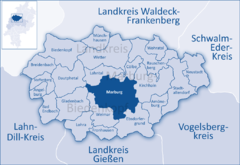Marburg
| Marburg | |
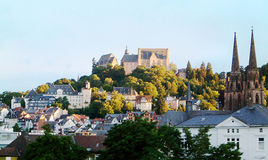 |
|
 |
|
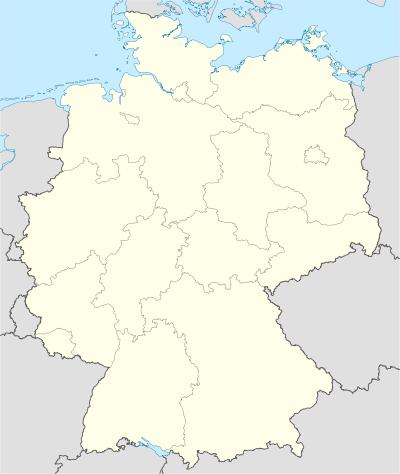 Marburg
|
|
|
Location of the town of Marburg within Marburg-Biedenkopf district
|
|
|---|---|
| Coordinates | |
| Administration | |
| Country | Germany |
| State | Hesse |
| District | Marburg-Biedenkopf |
| Town subdivisions | 20 Stadtteile |
| Lord Mayor | Egon Vaupel (SPD) |
| Basic statistics | |
| Area | 124.5 km2 (48.1 sq mi) |
| Elevation | 173-412 m |
| Population | 80,123 (31 December 2009)[1] |
| - Density | 644 /km2 (1,667 /sq mi) |
| Other information | |
| Time zone | CET/CEST (UTC+1/+2) |
| Licence plate | MR |
| Postal codes | 35001-35043 |
| Area code | 06421 |
| Website | www.marburg.de |
Marburg is a city in Hessen, Germany, on the River Lahn. It is the main town of the Marburg-Biedenkopf district and its population, as of September 2009, is 79,454.[2]
Contents |
History
Founding and early history

Like many settlements, Marburg developed at the crossroads of two important early medieval highways: the trade route linking Cologne and Prague and the trade route from the North Sea to the Alps and on to Italy), the former crossing the river Lahn here. The settlement was protected and customs were raised by a small castle built during the 9th or 10th century by the Giso. Marburg has been a town since 1140, as proven by coins. From the Gisos, it fell around that time to the Landgraves of Thuringia, residing on the Wartburg above Eisenach.
St Elizabeth
In 1228 the widowed princess-langravine of Thuringia, Elizabeth, chose Marburg as her dowager seat, as she did not get along well with her brother-in-law, the new Landgrave. The countess dedicated her life to the sick and would become after her early death in 1231, aged 24, one of the most eminent female saints, St Elisabeth of Hungary. She was canonized in 1235.
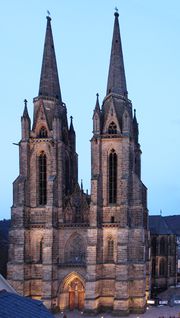
Capital of Hesse
In 1264, St Elizabeth's daughter Sophie of Brabant, succeeded in winning the Landgraviate of Hesse, hitherto connected to Thuringia, for her son Henry. Marburg (alongside Kassel) was one of the capitals of Hesse from that time until about 1540. Following the first division of the landgraviate, it was the capital of Marburg from 1485 to 1500 and again between 1567 and 1605. Hesse was one of the more powerful second-tier principalities in Germany. Its "old enemy" was the Archbishopric of Mainz, one of the Prince-electors, who competed with Hesse in many wars and conflicts for coveted territory, stretching over several centuries.
After 1605, Marburg became just another provincial town, known mostly for its university. It became a virtual backwater for two centuries after the Thirty Years' War, 1618-1648, when it was fought over by Hessen-Darmstadt and Hessen-Kassel (or Hessen-Cassel). The Hessian territory around Marburg lost more than two thirds of its population, which was more than in any later wars (including World War I and World War II) combined.
Reformation
Marburg is the seat of the oldest protestant university in the world, the University of Marburg (Philipps-Universität-Marburg), founded in 1527. It is one of the six classical "university villages" in Germany, the other five being Freiburg, Göttingen, Heidelberg, and Tübingen, as well as the city of Gießen, which is located 30 km south of Marburg.
In 1529, Philipp I of Hesse arranged the Marburg Colloquy, to propitiate Martin Luther and Huldrych Zwingli.
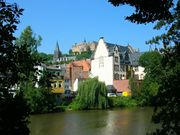
Romanticism
Owing to its neglect during the entire 18th century Marburg – like Rye or Chartres – survived as a relatively intact Gothic town, simply because there was no money spent on any new architecture or expansion. When Romanticism became the dominant cultural and artistic paradigm in Germany, Marburg became interesting once again, and many of the leaders of the movement lived, taught, or studied in Marburg. They formed a circle of friends that was of great importance, especially in literature, philology, folklore, and law. The group included Friedrich Karl von Savigny, the most important jurist of his day and father of the Roman Law adaptation in Germany; the poets, writers, and social activists Achim von Arnim, Clemens Brentano, and especially the latter's sister and former's later wife, Bettina von Arnim. Most famous internationally, however, were the Brothers Grimm, who collected many of their fairy tales here – Rapunzel's Tower stands in Amönau near Marburg, and across the Lahn hills, in the area called Schwalm, little girls' costumes included a red hood.
It has to be said, however, that this circle had disappeared from Marburg by the 1820s, and for another 45 years, Marburg became a Hessian backwater again.
Prussian town
In the Austro-Prussian War of 1866, the reactionary Prince-elector of Hesse had backed Austria; Prussia won, and invaded (without any bloodshed) and annexed Hesse-Kassel (as well as Hanover, the City of Frankfurt, and other territories) north of the Main river, while likewise pro-Austrian Hesse-Darmstadt remained independent. For Marburg, this turn of events was very positive, because Prussia decided to make Marburg its main administrative center in this part of the new province Hesse-Nassau and to turn the University of Marburg into the regional academic center. Thus, Marburg's rise as an administrative and university city began; as the Prussian university system was one of the best in the world at the time, Marburg attracted many respected scholars. However, there was hardly any industry to speak of, so students, professors, and civil servants – who generally had enough but not much money and paid very little in taxes – dominated the town, which tended to be very conservative.
20th century
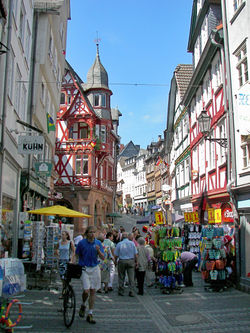
Franz von Papen, vice-chancellor of Germany in 1934, delivered an anti-Nazi speech at the University of Marburg on 17 June. This contributed to several of von Papen's staff being murdered by the Nazis.
From 1942 to 1945, the whole city of Marburg was turned into a hospital with schools and government buildings turned into wards to augment the existing hospitals. By the spring of 1945, there were over 20,000 patients – mostly wounded German soldiers. As a result of its being designated a hospital city, there was not much damage from bombings except along the railroad tracks.
In 1945, Marburg became President and Field Marshal Paul von Hindenburg's final resting place. His grave is in the Elisabethkirche. He is an honorary citizen of the town.
Marburg is also now home to one of the most progressive schools for the blind in the world. Street crossings are equipped with "walk" and "don't walk" signs that also emit sounds enabling the blind to know what the signs are "saying".
Main sights
Marburg is famous for its medieval churches, especially the Elisabethkirche, one of the two or three first purely Gothic churches north of the Alps outside of France and thus an incunable of Gothic architecture in Germany, as well as for the castle.
More important, however, is Marburg's city as such, an unspoilt, spire-dominated, castle-crowned Gothic/Renaissance city on a hill, intact because Marburg was an extreme backwater between 1600 and 1850. Unlike, for example, Rothenburg ob der Tauber, Marburg regained some of its importance in later centuries, so it is not a "museum village" but rather a student-dominated university town.
Much of the physical attractiveness of Marburg today is the legacy of the legendary Lord Mayor Dr. Hanno Drechsler (in office 1970-1992), who promoted urban renewal and the restoration, for the first time, by object and not by area; i.e., areas were not pulled down but rather buildings restored. Thus, at a time when other cities were still pulling down medieval quarters, Marburg already protected its unique heritage. Marburg also had one of the first pedestrian zones in Germany. Marburg's Altstadtsanierung (since 1972) has received many awards and prizes.
Politics
As a larger mid-sized city, Marburg, like six other such cities in Hesse, has a special status as compared to the other municipalities in the district. This means that the city takes on tasks more usually performed by the district so that in many ways it is comparable to an urban district (kreisfreie Stadt).
The mayor (Oberbürgermeister) Egon Vaupel, directly elected in January 2005 and in office since 1 July 2005, is from the Social Democratic Party of Germany. His deputy, the head of the building and youth departments Dr. Franz Kahle is supplied by Alliance '90/The Greens. The majority in the 59-seat city parliament is held by a coalition of SPD (20 seats) and Green (10 seats) members. Also represented are the factions of the CDU (17 seats), the PDS (4 seats), the Freie Wähler (Free Voters) BfM (Bürger für Marburg – 3 seats), the FDP (3 seats) and a CDU splinter group MBL (Marburger Bürgerliste- 2 seats).
Outside the parliament, there are in Marburg, like otherwise only in big cities, a full range of groupings. Among the leftwing groups are ATTAC, the Worldshop movement, an autonomist-anarchist scene, but also groups engaged in ecological or human-rights concerns.
The city of Marburg, similar to the cities of Heidelberg, Tübingen and Göttingen, has a rich history of student corporations or "Verbindungen"; i.e., associations or fraternities including Corps, Landsmannschaften, Burschenschaften, Turnerschaften, etc.
City partnerships
Marburg is twinned with the following towns[3]:
 Poitiers, France since 1961
Poitiers, France since 1961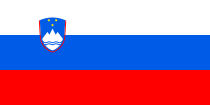 Maribor, Slovenia since 1969
Maribor, Slovenia since 1969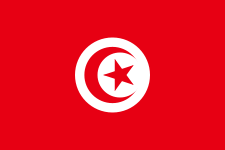 Sfax, Tunisia since 1971
Sfax, Tunisia since 1971 Eisenach, Thuringia since 1988
Eisenach, Thuringia since 1988 Northampton, United Kingdom since 1992
Northampton, United Kingdom since 1992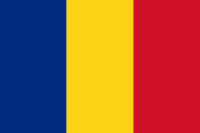 Sibiu, Romania since 2005
Sibiu, Romania since 2005
Coat of arms

Marburg's coat of arms shows a Hessian Landgrave riding a white horse with a flag and a shield on a red background. The shield shows the red-and-white-striped Hessian lion, also to be seen on Hesse's state arms, and the flag shows a stylized M, blue on gold (or yellow). The arms are also the source of the city flag's colours. The flag has three horizontal stripes coloured, from top to bottom, red (from the background), white (from the horse) and blue (from the shield).
The arms, which were designed in the late nineteenth century, are based on a landgrave's seal on a municipal document, which is an example of a very prevalent practice of replacing forgotten coats of arms, or ones deemed not to be representative enough, with motifs taken from seals. Under municipal codes in force in Germany today, the use of city or municipal arms in service seals is often mandatory.
Marburg virus
The city's name is also connected to a filovirus, the Marburg virus, which was first noticed and described during an outbreak in the city: workers were accidentally exposed to infected Green Monkey tissue at the city's main industrial plant (1967), the Behring-Werke, then part of Hoechst and today of CSL Behring, founded by Marburg citizen and first Nobel Prize in Medicine winner, Emil Adolf von Behring. During the outbreak, 31 people became infected and seven of them died. While this may seem a small number of people, during a cholera epidemic in the modern world only 1 in 20 people die. Marburg virus is named after the city per the custom of naming hemorrhagic fever viruses after the location of their first recorded outbreak.
Green city
Many homes have solar panels and in 2008, it was to become even compulsory to install solar systems in new buildings or as part of renovation projects. 20 percent of heating system requirements ought to have been covered by solar energy in new buildings. Anyone who fails to install solar panels would have been fined €1,000. The new law, approved on 20 June 2008, should have taken effect in October 2008.[4]. However, this law was stopped by the Regierungspräsidium Giessen in September 2008.[5].
There are also three wind turbines and several buses run on natural gas or bio diesel.
Places of interest
- Alter Botanischer Garten Marburg
- Neuer Botanischer Garten Marburg
- University of Marburg
- Elisabethkirche
References
- ↑ "Die Bevölkerung der hessischen Gemeinden" (in German). Hessisches Statistisches Landesamt. 31 December 2009. http://www.statistik-hessen.de/themenauswahl/bevoelkerung-gebiet/regionaldaten/bevoelkerung-der-hessischen-gemeinden/index.html.
- ↑ "Bevölkerung der hessischen Gemeinden". Hessisches Statistisches Landesamt. http://www.statistik-hessen.de/themenauswahl/bevoelkerung-gebiet/regionaldaten/bevoelkerung-der-hessischen-gemeinden/index.html. Retrieved 3 April 2010. (German)
- ↑ "Partnerstädte". City of Marburg. http://www.marburg.de/detail/11753. Retrieved 3 April 2010. (German)
- ↑ German college town Marburg becomes first in nation to require solar panels on new buildings, International Herald Tribune
- ↑ Marburger Solarsatzung vor dem aus (in german)
External links
- Official website of Marburg (German) + (English)
- Marburg travel guide from Wikitravel
|
|||||||
|
|||||||
